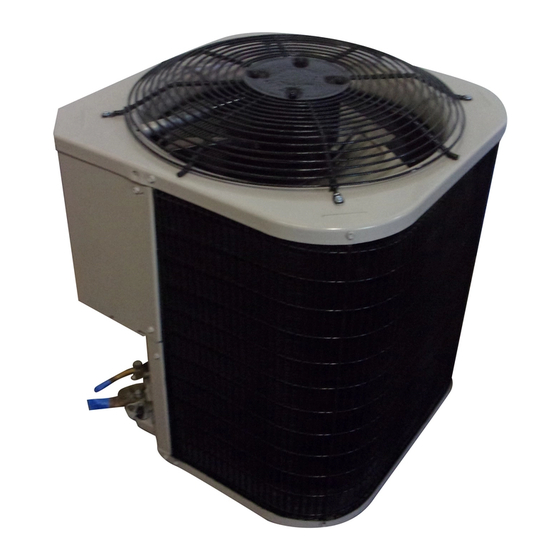Advertisement
Installation Instructions
SAFETY
CONSIDERATIONS
Improper installation,
acljustment, alteration, service,
maintenance,
or use
can
cause
explosion,
fire,
electrical
shock,
or
other
conditions
which
may
cause death,
personal
iniury,
or property
damage.
Consult
a qualified
installer,
service
agency,
or your
distributor
or branch
for information
or assistance.
The qualified
installer or agency
must use factory-authorized
kits or accessories
when modifying
this product.
Refer to the individual
instructions
packaged
with the kits or accessories
when
installing.
Follow
all safety
codes.
Wear safety glasses,
protective
clothing,
and work
gloves.
Use quenching
cloth
for brazing
operations.
Have
fire
extinguisher
available.
Read
these
instructions
thoroughly
and
follow
all warnings
or cautions
included
in
literature
and attached
to the unit. Consult local building
codes and
current editions
of the National
Electrical
Code ( NEC ) NFPA 70.
In Canada,
refer to current editions
of the Canadian
electrical
code
CSA 22.1.
Recognize
safety information.
This
is the safety-alert
symbol/k
When
you
see this
symbol
on the unit
and in instructions
or
manuals,
be alert to the potential
for personal
injury.
Understand
these
signal
words;
DANGER,
WARNING,
and
CAUTION.
These
words
are used
with
the
safety-alert
symbol.
DANGER
identifies
the
most
serious
hazards
which
will result
in severe
personal
injury or death. WARNING
signifies
hazards
which could
result
in personal
injury
or death.
CAUTION
is used to identify
unsafe
practices
which
would
result
in minor
personal
injury
or
product
and
property
damage.
NOTE
is used
to
highlight
suggestions
which
will result
in enhanced
installation,
reliability,
or operation.
ELECTRICALSHOCK
HAZARD
Failure to follow
this warning
could
result in personal
injury
or death.
Before
installing,
modifying,
or servicing
system,
main
electrical
disconnect
switch
must
be in the
OFF
position.
There may be more
than 1 disconnect
switch.
Lock
out and
tag switch with a suitable warning
label.
INSPECT
NEW UNIT
After
un-crating
unit,
inspect
thoroughly
for hidden
damage.
If
damage
is found,
notify
the transportation
company
immediately
and file a concealed
damage
claim.
LOCATION
Check
local
codes
for
regulations
concerning
zoning,
noise,
platforms,
and other issues.
Locate
unit
away
from
fresh
air
intakes,
vents,
or bedroom
windows.
Noise
may carry into the openings
and disturb
people
inside.
Locate
unit in a well drained
area, or support
unit high enough
so
that water runoff will not enter the unit.
Locate
unit away from areas where heat, lint, or exhaust
fumes will
be discharged
onto unit (as from dryer vents).
Locate
unit
away
from
recessed
or
confined
areas
where
recirculation
of discharge
air may occur
(refer
to CLEARANCE
REQUIREMENT
section
of this document).
Roof-top
installation
is acceptable
providing
the roof will support
the
unit
and
provisions
are
made
for
water
drainage
and
noise/vibration
dampening.
NOTE:
Roof mounted
units exposed
to wind may require
wind
baffles.
Consult
the manufacturer
for additional
information.
CLEARANCE
REQUIREMENTS
Nominal
minimum
clearances
are 48 inches (1.2m)
above unit for
discharge
air and 18 inches (457 mm) on each side of the coil for
intake
air. Clearance
on any one side of the coil (normally
between
unit and structure)
may be reduced
to 6 inches (152 mm). Nominal
minimum
clearances
are based
on a solid parallel
object
such as a
wall or roof overhang.
The clearance
may be reduced
for a single object with small surface
area, such
as the end of a wall,
outside
corner
of a wall, fence
section,
post, etc. As a general
rule,
the minimum
clearance
from
the unit should equal the width of the object. For example,
a 6 inch
(152 mm) fence post should
be a minimum
of 6 inches (152 mm)
from the unit.
Do not install unit under roof overhangs
unless
gutters
are present.
A minimum
vertical
clearance
of 48 inches (1.2m)
is required
to
the overhang.
Inside
corner
locations
on
single
story
structures
require
evaluation.
Large overhanging
soffit may cause air recirculation
in
a corner
area even though
recommended
minimum
clearances
are
maintained.
As a guide,
locate the unit far enough
out so that half
of the discharge
grille is out from under the soffit.
When placing
two or more units side-by-side,
provide
a minimum
of 18 inches (457 mm) between
units.
Provide
minimum
service
clearance
of 24 inches
(610 mm) from
control
box corner and side service panel. See Fig. 1.
Advertisement
Table of Contents










Need help?
Do you have a question about the PA13NR018 and is the answer not in the manual?
Questions and answers
what size capacitor for payne pa13nr042-h